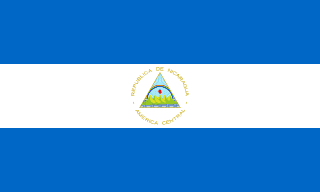Nicaragua - Geography

Here, let us take a look at the Geography of Nicaragua. Largest country in Central America; contains the largest freshwater body in Central America, Lago de Nicaragua. Mother's mean age at first birth is 19.2 years (2011/12 est.) (Note: data represents median age at first birth among women 25-29), whereas, the Maternal mortality ratio is 60 deaths/100,000 live births (2023 est.)
Geographical data of Nicaragua
| Location | Central America, bordering both the Caribbean Sea and the North Pacific Ocean, between Costa Rica and Honduras |
|---|---|
| Geographic coordinates | 13 00 N, 85 00 W |
| Map references | Central America and the Caribbean |
| Tarrain | extensive Atlantic coastal plains rising to central interior mountains; narrow Pacific coastal plain interrupted by volcanoes |
| Natural Resources | gold, silver, copper, tungsten, lead, zinc, timber, fish |
| Natural Hazards | destructive earthquakes; volcanoes; landslides; extremely susceptible to hurricanes volcanism: significant volcanic activity; Cerro Negro (728 m) is one of Nicaragua's most active volcanoes; its lava flows and ash have been known to cause significant damage to farmland and buildings; other historically active volcanoes include Concepcion, Cosiguina, Las Pilas, Masaya, Momotombo, San Cristobal, and Telica |
| Irrigated Land | 1,990 sq km (2012) |
| Major rivers (by length in km) | |
| Major aquifers | |
| Land Boundaries | 1,253 km |
| Border Countries | Costa Rica 313 km; Honduras 940 km |
| Coastline | 910 km |
| Climate | tropical in lowlands, cooler in highlands |
| Area | |
| Total Area | |
| Land Area | 119,990 sq km |
| Water Area | 10,380 sq km |
| comparative Area | slightly larger than Pennsylvania; slightly smaller than New York State |
| Maritime Claims | |
| Territorial sea | 12 nm |
| Contiguous zone | 24 nm |
| Continental shelf | natural prolongation |
| Elevations | |
| Highest point | Mogoton 2,085 m |
| Lowest point | Pacific Ocean 0 m |
| Mean elevation | 298 m |
| Land Use | |
| Agricultural land | 42.3% (2023 est.) |
| Agricultural land: arable land | arable land: 12.5% (2023 est.) |
| Agricultural land: permanent crops | permanent crops: 2.5% (2023 est.) |
| Agricultural land: permanent pasture | permanent pasture: 27.4% (2023 est.) |
| Forest | 40.1% (2023 est.) |
| Other | 17.6% (2023 est.) |
Population Distribution
The overwhelming majority of the population resides in the western half of the country, with much of the urban growth centered in the capital city of Managua; coastal areas also show large population clusters
People and Society
In Nicaragua, the different Ethnic groups are such that we have: Mestizo (mixed Indigenous and White) 69%, White 17%, Black 9%, Indigenous 5%
| Population | |
|---|---|
| Pop growth rate | 0.95% (2024 est.) |
| Birth rate | 16.4 births/1,000 population (2024 est.) |
| Death rate | 5.1 deaths/1,000 population (2024 est.) |
| Health expenditure | |
| Physicians Density | |
| Hospital bed Density | 0.9 beds/1,000 population (2021 est.) |
| Total fertility rate | 1.83 children born/woman (2024 est.) |
| Gross reproduction rate | 0.89 (2024 est.) |
| Contraceptive prevalence rate | |
| Est married women (ages 15-49) | 56% (2023 est.) |
| Literacy | |
| Education expenditures | |
| Net Migration rate | -1.8 migrant(s)/1,000 population (2024 est.) |
| Nationality | Nicaraguan | Nicaraguan(s) |
| Languages | |
| Religions | Roman Catholic 44.9%, Protestant 38.7% (Evangelical 38.2, Adventist 0.5%), other 1.2%, (includes Jehovah's Witness and Church of Jesus Christ), believer but not belonging to a church 1%, agnostic or atheist 0.4%, none 13.7%, unspecified 0.2% (2020 est.) |
| Age Structure | |
| 0-14 years | 25.1% (male 855,256/female 818,714) |
| 15-64 years | 68.9% (male 2,240,297/female 2,360,244) |
| 65 years and over | 6% (2024 est.) (male 178,347/female 224,090) |
| Dependency Ratios | |
| Total dependency ratio | 45.1 (2024 est.) |
| Youth dependency ratio | 36.4 (2024 est.) |
| Elderly dependency ratio | 8.7 (2024 est.) |
| Potential support ratio | 11.4 (2024 est.) |
| Median Age | |
| Total | 29 years (2024 est.) |
| Male | 28.1 years |
| Female | 29.9 years |
| Urbanization | |
| Urban population | 59.8% of total population (2023) |
| Rate of urbanization | 1.45% annual rate of change (2020-25 est.) |
| Major urban areas (Pop) | 1.095 million MANAGUA (capital) (2023). |
| Sex Ratio | |
| At birth | 1.05 male(s)/female |
| 0-14 years | 1.04 male(s)/female |
| 15-64 years | 0.95 male(s)/female |
| 65 years and over | 0.8 male(s)/female |
| Total population | 0.96 male(s)/female (2024 est.) |
| Infant Motality | |
| Total | 14.4 deaths/1,000 live births (2024 est.) |
| Male | 15.9 deaths/1,000 live births |
| Female | 12.8 deaths/1,000 live births |
| Life Expectancy at birth | |
| Total population | 74.7 years (2024 est.) |
| Male | 73.2 years |
| Female | 76.4 years |
| Sanitation facility acess | |
| Unimproved: rural | rural: 33.5% of population |
| Alcohol consumption per capita | |
| Total | 3.69 liters of pure alcohol (2019 est.) |
| Beer | 1.57 liters of pure alcohol (2019 est.) |
| Wine | 0.02 liters of pure alcohol (2019 est.) |
| Spirits | 2.1 liters of pure alcohol (2019 est.) |
| Other alcohols | 0 liters of pure alcohol (2019 est.) |
Demographic profile
All Important Facts about Nicaragua
Want to know more about Nicaragua? Check all different factbooks for Nicaragua below.









